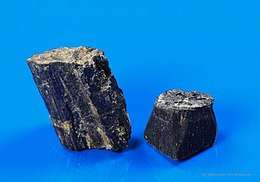Baotite
Baotite Ba4Ti4(Ti, Nb, Fe)4(Si4O12)O16Cl is a rare mineral recognized as having a unique four-fold silicate ring.[3] Crystals are tetragonal, though commonly deformed to the extent of appearing monoclinic. Named for the locality of first discovery, Baotou, China, baotite has been found in hydrothermal veins and alkalic rocks in various locations around the world.
| Baotite | |
|---|---|
 Baotite from Sheep Creek, Mineral Point District, Ravalli County, Montana | |
| General | |
| Category | Cyclosilicate |
| Formula (repeating unit) | Ba4Ti4(Ti,Nb,Fe)4(Si4O12)O16Cl |
| Strunz classification | 9.CE.15 |
| Crystal system | Tetragonal |
| Crystal class | Dipyramidal (4/m) H-M symbol: (4/m) |
| Space group | I41/a |
| Identification | |
| Color | light brown to black |
| Crystal habit | anhedral to subhedral, prismatic and striated parallel to (001) |
| Cleavage | fair on {110} |
| Fracture | hackly |
| Tenacity | brittle |
| Mohs scale hardness | 6 |
| Luster | vitreous |
| Density | 4.42-4.71 g/mL (measured), 4.69 g/mL (calculated) |
| Optical properties | Uniaxial (+) |
| Refractive index | nω = 1.94, nε > 2.00 |
| Pleochroism | strong |
| Absorption spectra | E > O |
| References | [1][2] |
Structure
Simonov first determined the crystal structure of baotite in which (Ti, Nb, Fe)-octahedra share edges, forming chains and cross-linking at the corners forming a 4-fold screw axis in the (001); these columns are analogous to those in rutile.[4] Four silicate tetrahedra share corners creating characteristic rings in the plane perpendicular to the c axis.[5] The barium cation is between the rings and rutile columns, while chloride fills the void between each pair of rings.[6] Chlorine's presence is not necessary for the structure to balance electrostatically.
Geologic occurrence
The first sample of baotite was found with galena, pyrite, albite, aegirine and alkali amphiboles in a quartz vein cutting quartzite[7] at the Bayan Obo Mine in China. Grains from Ravalli County, Montana were found in a thin calcite crust on masses of eschynite within a carbonatic vein.[8] Baotite also occurs at Haast River, New Zealand as an accessory phase of carbonatite, fenite and hydrothermal fluid veins associated with a dike swarm.[6] The dike intrusion of mantle-derived magmas[6] can likely be attributed to the close proximity of the Alpine fault plate boundary across South Island, New Zealand.
References
- Mineralienatlas
- Anthony, J.W., Bideaux, R., Bladh, K., and Nichols, M. (2003) Baotite Ba4(Ti,Nb)8Si4O28Cl. Handbook of Mineralogy, Mineral Data Publishing (Republished by the Mineralogical Society of America).*Fact sheet
- Chakhmouradian, A.R. and Mitchell, R.H. (2002) The mineralogy of Ba- and Zr-rich alkaline pegmatites from Gordon Butte, Crazy Mountains (Montana, USA): comparisons between potassic and sodic agpaitic pegmatites. Contributions to Mineralogy and Petrography, 143, 93-114.
- Simonov, V.I. (1960) Baotite, a mineral with a metasillicate ring (Si4O12). Kristallografiya, 5, 544-546 (in Russian). Abs. in American Mineralogist, 46, 466, 1961.
- Shinno, I. and Li, Z. (1998) Mössbauer studies of baotite and bafertisite. Hyperfine Interactions, 116, 189-196.
- Cooper, A.F. (1996) Nb-rich baotite in carbonatites and fenites at Haast River, New Zealand. Mineralogical Magazine, 60, 473-482.
- Peng, C.J. (1959) The discovery of several new minerals of rare elements. Ti-Chin Ko-hsuch, 10 (in Chinese). Abs. in American Mineralogist, 45, 754, 1960.
- Heinrich, E.W., Boyer, W.H. and Crowley, F.A. (1962) Baotite (Pou-t’ou-k’uang) from Ravalli County, Montana. American Mineralogist, 47, 987-993.